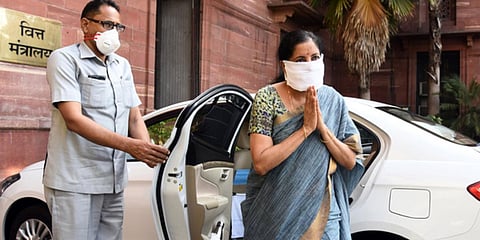

As the Government draws up its second fiscal stimulus package, top economists, policymakers and India Inc. leaders fear it may be too little, too late.
While the Government’s first stimulus tranche was an underwhelming 0.7 per cent of GDP at Rs 1.7 lakh crore, the next tranche which is believed to be still in the works is widely expected to be between 0.5-1 per cent of GDP.
Against this, experts believe a fiscal stimulus of 5-10 per cent of the country's GDP is required to put the economy back on the rails.
Dr Sangeeta Reddy, president of FICCI, estimates that India requires a stimulus of at least Rs 10 lakh crore or about 5 per cent of GDP, while Prof Biswajit Dhar of JNU’s Centre for Economic Studies and Planning, estimates that the Government needs to plan for up to 10 per cent of GDP as stimulus given the longer lock-in India has gone in for.
Former finance secretary S C Garg in an interaction with The New Indian Express too said the Government needs Rs 10 lakh crore "half of it for covering revenue shortfall, remaining Rs 5 lakh crore for survival package for workers... (with) a review in July-August, by when a new budget may be needed."
Small businesses, which were struggling to survive, have been badly hit by the prolonged lockdown and most are not in a position to pay wages or meet overhead costs. Much of the emergency cash is needed for payroll and overhead cost support for these businesses and their employees.
Last week, the former Solicitor General of India Harish Salve at a summit meet in Chennai, had advocated what he termed as "blood transmission, i.e cash, into the system" by printing money if need be and putting on the backburner a host of irritants such as "statutory compliances, tax disputes and intrusive investigation into small violations" in order to smooth the path of business revival. Most experts tended to agree with him.
Salve also advocated the removal of bankers from the purview of the PCA. "Which bank officer would risk sanctioning a loan? He would be hounded if the loan is not repaid."
The former Solicitor General had also suggested that Indian corporates be allowed to take advantage of low-interest rates in global markets by borrowing there.
The Indian economy ravaged by the Coronavirus pandemic is expected to grow by 0.2 per cent by Moody’s, while many independent economists believe it could actually contract if the right stimulus is not delivered at the right time.
The USA has already announced stimulus measures amounting to about 11 per cent of its GDP, while France has come up with its stimulus package equal to 14 per cent of its GDP. Experts believe that India can raise debt easily to fund any stimulus programme.
"Our debt to GDP ratio is reasonable," points out Reddy.
India’s public debt stands at 69 per cent of GDP, comfortably below its peers. The US has a 107 per cent debt to GDP ratio, while France has 98.4 per cent and Japan a whopping 238.2 per cent.
"Much of the money that has to be spent has to be for emergency wage support, reviving MSMEs, support or the worst-hit sectors and very importantly for Government's own infrastructure spending, all of which would create demand in the economy to pull up the rest of the sectors," said Ravi Srivatstava, former chairperson, Centre for Regional Development, JNU. The Government has drawn up a five-year plan worth Rs 111 lakh crore for infrastructure projects.
However, much of this planning is still on paper and experts argue there is a pressing need to step up work on it.
Experts also point out that the Government has been trying to channel funding to industry through the banking system, by cutting lending rates and extending new credit lines, without much success as bankers' have been reluctant to lend given paucity of strong borrowers and fear that once loans fail they may be hauled up under the prevention of corruption act.
"A helping hand has to be given to MSMEs... a partial or full guarantee by the Government for loans to them along with stipulations which ensure that re-payment would nudge banks into lending," said Sanjay Bhattacharyya, former Managing Director of State Bank of India.
Many experts believe that moratoriums given to businesses for a quarter or six months may not suffice and a longer moratorium of up to a year may be thought of. Banks have also held back on passing on rate cut benefits, in the absence of direct orders from the banking regulator. "Banks are risk averse... lending may improve if there are direct orders that rate cuts be passed on," said Srivastava.